Evaluation of the tensile stress-strain properties in the thickness ...
Evaluation of the tensile stress-strain properties in the thickness ...
Evaluation of the tensile stress-strain properties in the thickness ...
Create successful ePaper yourself
Turn your PDF publications into a flip-book with our unique Google optimized e-Paper software.
Fig 16. Stra<strong>in</strong> at break versus density for <strong>the</strong> <strong>in</strong>vestigated handsheets.<br />
vary<strong>in</strong>g structural density. This was a prerequisite for a<br />
more precise evaluation <strong>of</strong> <strong>the</strong> deformation <strong>of</strong> paper. The<br />
results <strong>in</strong> terms <strong>of</strong> elastic moduli showed that when<br />
evaluat<strong>in</strong>g <strong>the</strong> <strong>stra<strong>in</strong></strong> related <strong>properties</strong>, <strong>the</strong> <strong>in</strong>fluence <strong>of</strong><br />
<strong>the</strong> adhesive could not be neglected even for higher<br />
grammages. Byrd et al. (Byrd et al. 1975) apply an<br />
adhesive similar to <strong>the</strong> one used <strong>in</strong> <strong>the</strong> present study, but<br />
<strong>the</strong>y assume that <strong>the</strong> adhesive has an <strong>in</strong>f<strong>in</strong>ite stiffness.<br />
This might be a reason for <strong>the</strong>ir calculated adhesive<br />
penetration which is significantly lower than <strong>the</strong> one<br />
presented <strong>in</strong> this paper.<br />
A large discrepancy was found between <strong>the</strong> Z-directional<br />
<strong>tensile</strong> strength measured us<strong>in</strong>g adhesive and double<br />
adhesive tape. This was not unexpected s<strong>in</strong>ce <strong>the</strong> strength<br />
results for <strong>the</strong> chemical pulps lie on <strong>the</strong> border or outside<br />
<strong>the</strong> recommended measurement range accord<strong>in</strong>g to<br />
SCAN P80:98. Consequently, reliable Z-directional<br />
strength values for strong papers can only be obta<strong>in</strong>ed by<br />
ensur<strong>in</strong>g a paper-adhesive bond<strong>in</strong>g which is stronger than<br />
<strong>the</strong> paper itself.<br />
A possible drawback for <strong>the</strong> presented method is <strong>the</strong><br />
densification <strong>of</strong> TMP dur<strong>in</strong>g <strong>the</strong> press<strong>in</strong>g process, which<br />
might have an effect on <strong>the</strong> mechanical <strong>properties</strong>.<br />
However, <strong>the</strong> strength results obta<strong>in</strong>ed with commercial<br />
apparatus did not differ, <strong>in</strong> <strong>the</strong> range <strong>of</strong> <strong>the</strong> acceptable<br />
grammages, from <strong>the</strong> ones obta<strong>in</strong>ed by <strong>the</strong> custom built<br />
apparatus.<br />
The chosen pressure ensured a sufficient penetration <strong>of</strong><br />
<strong>the</strong> glue and sufficient bond<strong>in</strong>g between <strong>the</strong> glue and<br />
paper. In <strong>the</strong> future, a reduction <strong>of</strong> <strong>the</strong> cur<strong>in</strong>g time<br />
obta<strong>in</strong>ed by us<strong>in</strong>g more suitable glue comb<strong>in</strong>ed with a<br />
decrease <strong>of</strong> <strong>the</strong> cur<strong>in</strong>g pressure may be <strong>the</strong> way to avoid<br />
<strong>the</strong> densification.<br />
The decrease <strong>in</strong> Z-directional <strong>tensile</strong> strength for<br />
<strong>in</strong>creas<strong>in</strong>g grammage observed for <strong>the</strong> chemical pulps<br />
can be expla<strong>in</strong>ed by <strong>the</strong> Weak L<strong>in</strong>k Theory. Handsheets<br />
with higher grammages present a higher number <strong>of</strong><br />
distributed defects trigger<strong>in</strong>g failures at lower <strong>stress</strong>es.<br />
On <strong>the</strong> o<strong>the</strong>r hand, <strong>the</strong> Z-directional <strong>tensile</strong> strength for<br />
TMP sheets rema<strong>in</strong>ed constant over <strong>the</strong> range <strong>of</strong> <strong>the</strong><br />
acceptable grammages. One explanation might be that<br />
<strong>the</strong> defect sensitivity is related to <strong>the</strong> density <strong>of</strong> <strong>the</strong> fiber<br />
network. The adhesive penetration does not allow test<strong>in</strong>g<br />
grammages less than 60 g/m 2 . Test<strong>in</strong>g <strong>of</strong> th<strong>in</strong>ner paper<br />
may require a ref<strong>in</strong>ement <strong>of</strong> <strong>the</strong> technique.<br />
In l<strong>in</strong>e with <strong>the</strong> previous results on <strong>the</strong> subject, it was<br />
shown that density caused an exponential <strong>in</strong>crease <strong>in</strong><br />
both Z-directional <strong>tensile</strong> strength and <strong>the</strong> elastic<br />
modulus for <strong>the</strong> tested material. It is likely that <strong>the</strong> f<strong>in</strong>es<br />
cause <strong>the</strong> <strong>in</strong>crease <strong>of</strong> strength for <strong>the</strong> beaten pulps but<br />
less <strong>in</strong>fluence on <strong>the</strong> Z-directional elastic modulus is<br />
expected. The magnitude <strong>of</strong> <strong>the</strong> elastic modulus is <strong>in</strong><br />
agreement with <strong>the</strong> previous literature data. With regard<br />
to <strong>the</strong> fiber shape, two ma<strong>in</strong> concurrent structural factors<br />
<strong>in</strong>fluenc<strong>in</strong>g <strong>the</strong> Z-directional elastic modulus <strong>of</strong> paper<br />
can be identified. A consequence <strong>of</strong> <strong>in</strong>creas<strong>in</strong>g density is<br />
a lower free fiber segment length correspond<strong>in</strong>g to higher<br />
resistance to bend<strong>in</strong>g for s<strong>in</strong>gular fibers. This phenomenon<br />
may have positive effect on <strong>the</strong> Z-directional elastic<br />
modulus <strong>of</strong> paper. The fiber collapse, caused by beat<strong>in</strong>g,<br />
on <strong>the</strong> o<strong>the</strong>r hand, reduces <strong>the</strong> <strong>thickness</strong> <strong>of</strong> <strong>the</strong> fiber and<br />
<strong>the</strong>refore <strong>the</strong> bend<strong>in</strong>g stiffness <strong>of</strong> <strong>the</strong> s<strong>in</strong>gle fiber drops.<br />
This fact is likely to be detrimental to <strong>the</strong> elastic moduli<br />
<strong>of</strong> paper.<br />
S<strong>in</strong>ce <strong>the</strong> elastic modulus <strong>in</strong>creases with density, <strong>the</strong><br />
negative effect <strong>of</strong> fiber collapse seems to be negligible<br />
over reduction <strong>of</strong> <strong>the</strong> free fiber length.<br />
Conclusions<br />
·<br />
·<br />
·<br />
·<br />
·<br />
A method for <strong>the</strong> measurement <strong>of</strong> <strong>stress</strong>-<strong>stra<strong>in</strong></strong> <strong>properties</strong><br />
<strong>of</strong> paper <strong>in</strong> <strong>the</strong> <strong>thickness</strong> direction was developed.<br />
The measurements were applicable for grammages<br />
over approximately 60g/m 2 .<br />
The paper <strong>properties</strong> were highly dependent on <strong>the</strong><br />
density. Higher density caused an exponential <strong>in</strong>crease<br />
<strong>in</strong> Elastic modulus, Z-directional strength, and a<br />
reduction <strong>of</strong> <strong>the</strong> <strong>stra<strong>in</strong></strong> at break<br />
The presented technique should help <strong>in</strong>creas<strong>in</strong>g <strong>the</strong><br />
knowledge <strong>of</strong> <strong>the</strong> relationship between <strong>the</strong> network<br />
structure and <strong>the</strong> mechanical <strong>properties</strong> <strong>of</strong> paper.<br />
The collected data may be used as a first approximation<br />
for model<strong>in</strong>g purposes <strong>of</strong> convert<strong>in</strong>g processes<br />
and end use performance.<br />
Acknowledgments<br />
The f<strong>in</strong>ancial support <strong>of</strong> <strong>the</strong> Surface Treatment Program at Karlstad University is<br />
acknowledged. The authors wish to thank <strong>the</strong> STFI-Packforsk partner companies<br />
participat<strong>in</strong>g <strong>in</strong> <strong>the</strong> Research Cluster ‘Eng<strong>in</strong>eered Paperboard’.<br />
Appendix I. F<strong>in</strong>d<strong>in</strong>g <strong>the</strong> displacement <strong>in</strong> <strong>the</strong> center <strong>of</strong><br />
<strong>the</strong> test piece.<br />
The aim <strong>of</strong> such calculation is to determ<strong>in</strong>e <strong>the</strong> displacement<br />
<strong>in</strong> <strong>the</strong> middle <strong>of</strong> <strong>the</strong> test piece. The displacement<br />
field <strong>of</strong> <strong>the</strong> all <strong>the</strong> po<strong>in</strong>ts <strong>in</strong> <strong>the</strong> test piece can be<br />
described as a plane <strong>in</strong> space, s<strong>in</strong>ce <strong>the</strong> test piece is<br />
rigidly connected to plane platens. The centre <strong>of</strong> <strong>the</strong> test<br />
piece is taken as <strong>the</strong> orig<strong>in</strong> <strong>of</strong> <strong>the</strong> coord<strong>in</strong>ate system. The<br />
displacements can be considered as <strong>the</strong> Z-coord<strong>in</strong>ates <strong>in</strong><br />
<strong>the</strong> space. The sensors yield <strong>the</strong> values <strong>of</strong> <strong>the</strong> dis-<br />
Nordic Pulp and Paper Research Journal Vol 22 no. 1/2007 55








